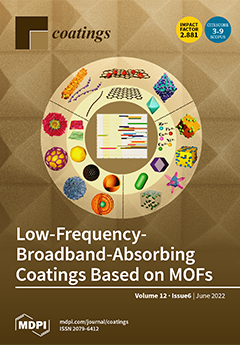This work reports on the synthesis of small molecular semiconductor 2-(1
H-pyrrol-1-yl)-anthracene-9,10-dione (PAD) via wet chemical precipitation route method for its possible potential applications in sensors. Thin film characterization of the synthesized PAD is carried out by studying its surface morphology, bond
[...] Read more.
This work reports on the synthesis of small molecular semiconductor 2-(1
H-pyrrol-1-yl)-anthracene-9,10-dione (PAD) via wet chemical precipitation route method for its possible potential applications in sensors. Thin film characterization of the synthesized PAD is carried out by studying its surface morphology, bond dynamics, and optical properties. For studying sensing characteristics of the PAD, its 100 nm thick film is thermally deposited on pre-patterned silver (Ag) electrodes over glass substrate having ~45 µm inter-electrode gaps to prepare Ag/PAD/Ag sensor. The effects of humidity (%RH), temperature (T), and illumination of light (E
v) on the fabricated Ag/PAD/Ag sensor are studied by changing one of the three (%RH, T, and E
v) parameters at a time and measuring the corresponding variations in capacitance (C) and capacitive reactance (X) of the device. As C and X also depend on frequency, sensing properties of the Ag/PAD/Ag sensor are measured at two different frequencies (120 Hz and 1 kHz) to find the optimum sensitivity conditions. To investigate reproducibility and repeatability of Ag/PAD/Ag sensor, each measurement is taken several times and also hysteresis loops of %RH vs. C are plotted at 120 Hz and 1 kHz to find the percent errors in each cycle of measurements. The sensor is active to sense humidity, temperature, and illumination within a broad range, i.e., from 15–93%RH, 293–382 K, and 1500–20,000 lx, respectively. Other key parameters of the sensor i.e., the humidity response time (T
Res) and recovery time (T
Rec), are measured, which are 5 and 7 s, respectively, whereas for light sensing the values of T
Res and T
Rec are measured to be 3.8 and 2.6 s, respectively. The measured values of T
Res and T
Rec for the fabricated Ag/PAD/Ag sensor are shorter and better as compared to those of previously reported for similar kind of small molecular based sensors. The sensing properties of Ag/PAD/Ag device exhibit the potential of PAD for humidity, temperature, and light sensing applications.
Full article





